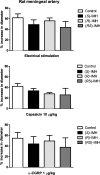Effects of two isometheptene enantiomers in isolated human blood vessels and rat middle meningeal artery - potential antimigraine efficacy
- PMID: 31053059
- PMCID: PMC6734216
- DOI: 10.1186/s10194-019-1003-2
Effects of two isometheptene enantiomers in isolated human blood vessels and rat middle meningeal artery - potential antimigraine efficacy
Abstract
Background: Racemic isometheptene [(RS)-isometheptene] is an antimigraine drug that due to its cardiovascular side-effects was separated into its enantiomers, (R)- and (S)-isometheptene. This study set out to characterize the contribution of each enantiomer to its vasoactive profile. Moreover, rat neurogenic dural vasodilatation was used to explore their antimigraine mechanism of action.
Methods: Human blood vessel segments (middle meningeal artery, proximal and distal coronary arteries, and saphenous vein) were mounted in organ baths and concentration response curves to isometheptene were constructed. Calcitonin gene-related peptide (CGRP)-induced neurogenic dural vasodilation was elicited in the presence of the enantiomers using a rat closed cranial window model.
Results: The isometheptene enantiomers did not induce any significant contraction in human blood vessels, except in the middle meningeal artery, when they were administered at the highest concentration (100 μM). Interestingly in rats, (S)-isometheptene induced more pronounced vasopressor responses than (R)-isometheptene. However, none of these compounds affected the CGRP-induced vasodilator responses.
Conclusion: The isometheptene enantiomers displayed a relatively safe peripheral vascular profile, as they failed to constrict the human coronary artery. These compounds do not appear to modulate neurogenic dural CGRP release, therefore, their antimigraine site of action remains to be determined.
Keywords: CGRP; Isolated vessels; Isometheptene; Migraine; Organ baths; Vasodilation.
Conflict of interest statement
The authors declare that they have no competing interests.
Figures



References
-
- Levy D, Labastida-Ramirez A, MaassenVanDenBrink A (2018) Current understanding of meningeal and cerebral vascular function underlying migraine headache. Cephalalgia:0333102418771350. 10.1177/0333102418771350 - PubMed
MeSH terms
Substances
Grants and funding
LinkOut - more resources
Full Text Sources
Medical
Research Materials

